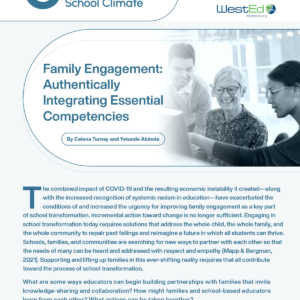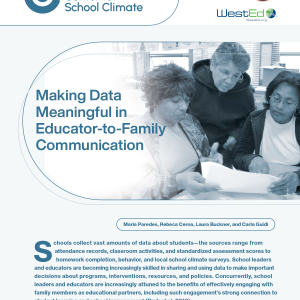Thriving Schools Go the Extra Mile to Welcome and Bond With Parents and Families
Posted on

By Maria Paredes, Senior Engagement Manager at WestEd
There’s something incredibly heartwarming about reading parents’ social media posts expressing their love and appreciation for their child’s school. These parents take the time to recommend their favorite and trusted teachers, describe a sense of community and belonging, and invite new families to join in on school activities, volunteer opportunities, and decision-making committees. Their loyalty and commitment to the school are unmistakable.
In today’s world, families have numerous school choices for their children and often rely on the experiences of neighbors, family, and friends for advice. Families’ perceptions of the school—how they feel when they walk into the front office, the quality and usability of the communication they receive, their ability to provide feedback and feel heard and valued, and their access to learning resources and school staff—are all crucial. This might sound a lot like customer service, and that’s precisely what it is.
Just as in the business world, positive communication and interactions between schools and their parents and families directly influence satisfaction, loyalty, and trust. This, in turn, can enhance student outcomes, enrollment, attendance, and behavior, according to the K12 Insight report (2023).
Strong relationships with families are also an effective strategy to improve student engagement and increase attendance, as evidenced by Attendance Works. Children in poverty, children of color, and children with disabilities are three times more likely to be chronically absent. A welcoming school that goes the extra mile to create a sense of belonging and build bonds with families can take proactive measures and work together with families to overcome attendance barriers.
This school year, schools should aim to create and nurture a sense of belonging and common purpose with families and the community. Here are some actionable suggestions:
Create a Family-Friendly Environment
Families should feel comfortable touring and visiting the school at any time during the school year. A welcoming environment includes convenient parking spaces, family-friendly signage, cleanliness, a friendly and helpful front office staff, a comfortable and inviting waiting area, translated materials, posted family engagement activities and events, and flyers informing families of enrichment opportunities available after school and in the community. A visit or call to the school should feel gratifying when the staff is knowledgeable and helpful and issues or concerns are resolved promptly.
Go the extra mile
- Advertise principal office hours when parents and students can stop by.
- Promote networking among families during an Open House by organizing grade-level meet-and-greet events and team-building activities.
- Use student pick-up and drop-off times as golden opportunities to make quick and friendly connections with families.
- Post empowering messages for families on the school outdoor sign.
- Actively recruit families to support decision-making and help identify the school’s vision and goals.
Enhance Family Engagement with Clear and Honest Communication
 Effective communication with families is clear, relevant, and personalized. Go beyond good intentions and engage in meaningful conversations that can lead to improved student learning.
Effective communication with families is clear, relevant, and personalized. Go beyond good intentions and engage in meaningful conversations that can lead to improved student learning.
Teachers can make a great first impression before school starts or at the beginning of the year by making a welcome phone call, sending a postcard, email, letter, or any other form of communication that helps families get to know their child’s teachers.
Encourage teachers to be relatable by sharing tidbits of their own lives; being a real person goes a long way in building relationships. Let families know the best way to contact their teacher for questions, guidance, or updates on student learning progress.
Transparent and honest communication builds trust. Prioritize communication linked to learning. Share student progress data as soon as it is available, inform families when and how students will be tested, and show parents specific activities and strategies they can use at home to help their children prepare. Report cards and parent-teacher conferences are not enough; families need concrete and personalized information and guidance to support learning.
Go the extra mile
- Implement quarterly listening circles with diverse groups of families to value parents’ perspectives and ideas and support school improvement.
- Anticipate communication barriers by understanding each family’s preferred language and communication method.
- Create school policies that encourage teachers to regularly connect with families and build time into the schedule to make it possible.
Expand Engagement Access for All Families
Traditionally, schools collect family engagement data based on parent and family attendance at school events and activities. Often, this means counting the regulars—the ones who come time after time. This school year, challenge your school team to count the families who were unable to attend the event, especially if the event is focused on student learning.
As a next step, divide the number of absent families by grade level and ask teachers to reach out to their families, let them know they were missed, and share the important information they missed. Take this opportunity to learn more about the family, build trust, and open new lines of communication. Create space for teachers to share what they learn with their grade-level team.
Go the extra mile
- Implement changes to family engagement opportunities using feedback and suggestions from prior years.
- Leverage nonclassroom staff to facilitate mini-make-up sessions for families who were unable to attend the learning-focused events.
Genuine family engagement happens away from school—it happens at the dinner table, in car rides, and during everyday parent-child interactions and family dynamics. Your efforts to deepen relationships with families can enrich the way families support learning and provide you with a fresh and improved perspective on the children you teach.
By making these efforts, schools can build stronger, more supportive communities that not only enhance student success but also create a vibrant, welcoming environment for everyone involved. Let’s make this school year the best one yet by going the extra mile for our families!
 Maria Paredes is dedicated to excellence and equity in family engagement. Paredes developed Academic Parent–Teacher Teams (APTT), a strengths-based model of family engagement designed to strengthen the capacity of teachers and families and transform family participation in their children’s education. This model has been adopted by over 2,000 schools throughout the nation and is the subject of multiple studies asserting positive outcomes for students, families, and schools.
Maria Paredes is dedicated to excellence and equity in family engagement. Paredes developed Academic Parent–Teacher Teams (APTT), a strengths-based model of family engagement designed to strengthen the capacity of teachers and families and transform family participation in their children’s education. This model has been adopted by over 2,000 schools throughout the nation and is the subject of multiple studies asserting positive outcomes for students, families, and schools.


